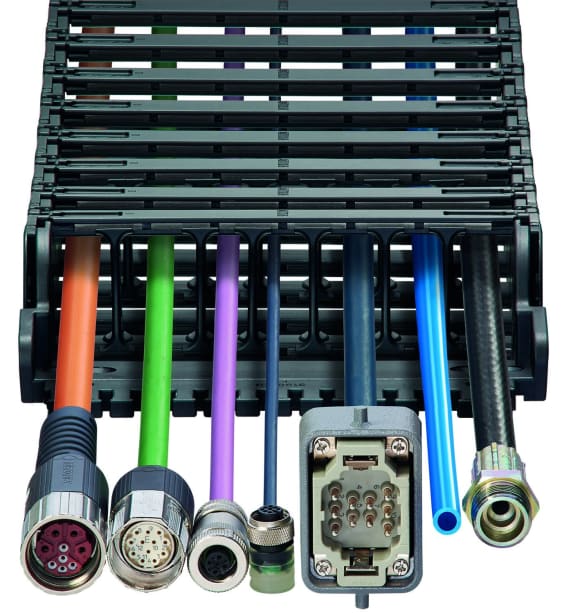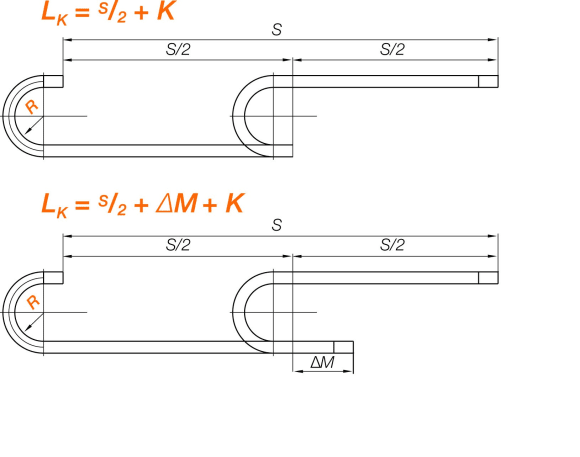7 cable management mistakes that you may be making
Follow articleHow do you feel about this article? Help us to provide better content for you.
Thank you! Your feedback has been received.
There was a problem submitting your feedback, please try again later.
What do you think of this article?
With modern cable carriers withstanding longer travels, faster speeds and higher loads than ever before advancements in automation technology mean that certain rules have become outdated. So that is where the-chain director at igus UK comes in. Justin Leonard has put together a list of seven, common cable management errors that you may not know you’re even making and how to avoid them in the future.
1. Lack of interior separation
Keeping your cables and hoses compartmentalised using interior separators and shelves is crucial, not doing this can result in the cables crossing over one another and becoming tangled or wearing. The clearance height of a compartment with several cables and hoses should not amount to more than 1.5 times the diameter of the largest cable or hose. Cables with wide differences in diameter should be laid in separate compartments. Cables and hoses with incompatible jackets should also be separated (see point #6 for more info on this). The max cable or hose diameter corresponds to the inner height of the selected energy chain, with additional minimum clearance. We recommend leaving a 10% clearance surrounding electrical cables, and 20% clearance surrounding hydraulic hoses.
The faster and more frequent an energy chain operates, the more important it is for the exact positioning of the cables and hoses inside. For high-speed applications, over 0.5 m/s, or for high cycle applications with over 10,000 cycles per year, cables or hoses must not be laid on top of one another without horizontal separation.
2. Uneven weight distribution
Cables and hoses need to be laid inside an energy chain so that they can move freely without exerting tensile forces along the radius. Unevenly distributed weight can result in an energy chain that is too heavy on one side, which can disrupt movement and cause it to tilt, potentially interfering with the work area. This is also very important for big hydraulic hoses, which can also cause an unbalanced chain to tilt when they are pressurised.
3. Overfilled cable carrier
While it may be hard to leave seemingly available energy chain space unfilled, overfilling can obstruct free movement. Cables that do not have room to move freely will interfere with the movement of the energy chain.
Additionally, if cables become caught on one another and bind, jacket abrasion can be increased. Thus a greater chance of electromagnetic interference, or EMI, when power and data cables are positioned close together. As a rule, we recommend that all power and data cables be spaced as far apart as possible to best prevent EMI.
4. Lack of adequate strain relief
Without the proper strain relief, there is no way to control the length of the cable inside the energy chain.
As it moves back and forth, the cable will pull into the energy chain and bunch up, which could cause premature system failure. Points outside the energy chain, such as connectors or end termination points, will also absorb all mechanical forces.
Typically, round electrical cables should be secured with strain relief at both ends. For hydraulic hoses, which can lengthen and shorten under pressure, strain relief is needed at the moving end only. A gap of no more than 10-30 times the cable diameter between the end of the bend radius and the fixing point is recommended.
5. Not installing cables along the neutral axis
Correctly strain relieved cables will position in the neutral axis of an energy chain - the cables should not be pulled tight against the inner radius or pushed against the outer radius.
Strain relief should be installed properly, and then tested in both the extended and home positions.
6. Dissimilar jacket types placed next to each other
If the outer jacket of cables/hoses have different coefficients of friction and rub against one another, the harder, more resilient material will gradually wear down the softer jacket, leading to failure.
While PUR and TPE jackets have similar wear characteristics and laying these types of cables together is not a problem, mixing PVC and PUR jackets is not ideal.
If jacket materials are mixed within the same energy chain, then ensure that jacket materials are rated for use in energy chains. Rubber or thermoset jacket materials tend to have tackier surfaces and will bind inside cable carriers, and are therefore not recommended as outer jacket materials when using a cable carrier system.
7.Improper energy chain length
If the energy chain’s length is miscalculated, then the full range of movement could be greatly compromised. Pulled or overstretched cables can result in conductor breakage.
To properly calculate the length of an energy chain, use the following equations:
LK = S/2 + K or LK = S/2 + ΔM + K
If the fixed end is located in the centre of travel, the energy chain’s length, “LK,” is calculated by using half the length of travel, and adding the value “K” for the bend radius. Placing the fixed end in the centre of travel is the most cost-effective solution, as it requires the shortest possible energy chain and cable/hose lengths. When the fixed end is not located in the centre, the offset mounting value (ΔM) must be added.




